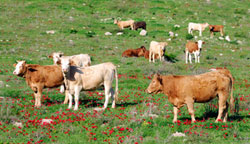Prediction power for Map transmission
Map or Mycobacterium a.paratuberculosis is a disease that causes widespread losses in domestic ruminants. The prime means of transmission is through the ingestion of faeces. It may also be passed on via milk to suckling animals. Recently, the disease has been found in non-ruminant wildlife and this has caused concern because of the potential infective reservoir posed by animals such as rabbits. The disease may remain hidden or dormant within the infected animal. Young animals that have contracted the disease may not show any symptoms until adulthood, thus increasing the infective pool if not removed from the herd. The bacteria are shed with the faeces and subsequent ingestion can lead to infection. Just how to improve control of this bacterial disease became the objective of the project, PARA-TB TRANSMISSION. Their overall aim was to identify the wild species that carry the infection and to pinpoint high-risk routes of transmission. Realistic models were developed that could predict levels of infection under a range of situations. The project team at the University of Thessaly in Greece developed models with a range of parameters to maximise the predictive ability. The transmission from wildlife was determined at different rates from zero (shedding in faeces) to 50%. The timing as regards culling of infected cattle was also considered to be of high importance. The period from when symptoms were diagnosed and when the cattle became infectious to culling were varied. Whether the calving occurred outdoors was also taken into consideration so the situations from total calving outdoors through to calving exclusively indoors were modelled. Calving management, hygiene, and location of calving were found to be much more important than risk of infection from wildlife. Based on comprehensive modelling parameters, these results have no doubt enhanced the predictive power of previously developed models. The highest impact from wildlife was found in large farms with solely outdoor calving. It was therefore recommended that further research regarding wild animals be carried out using these parameters.







